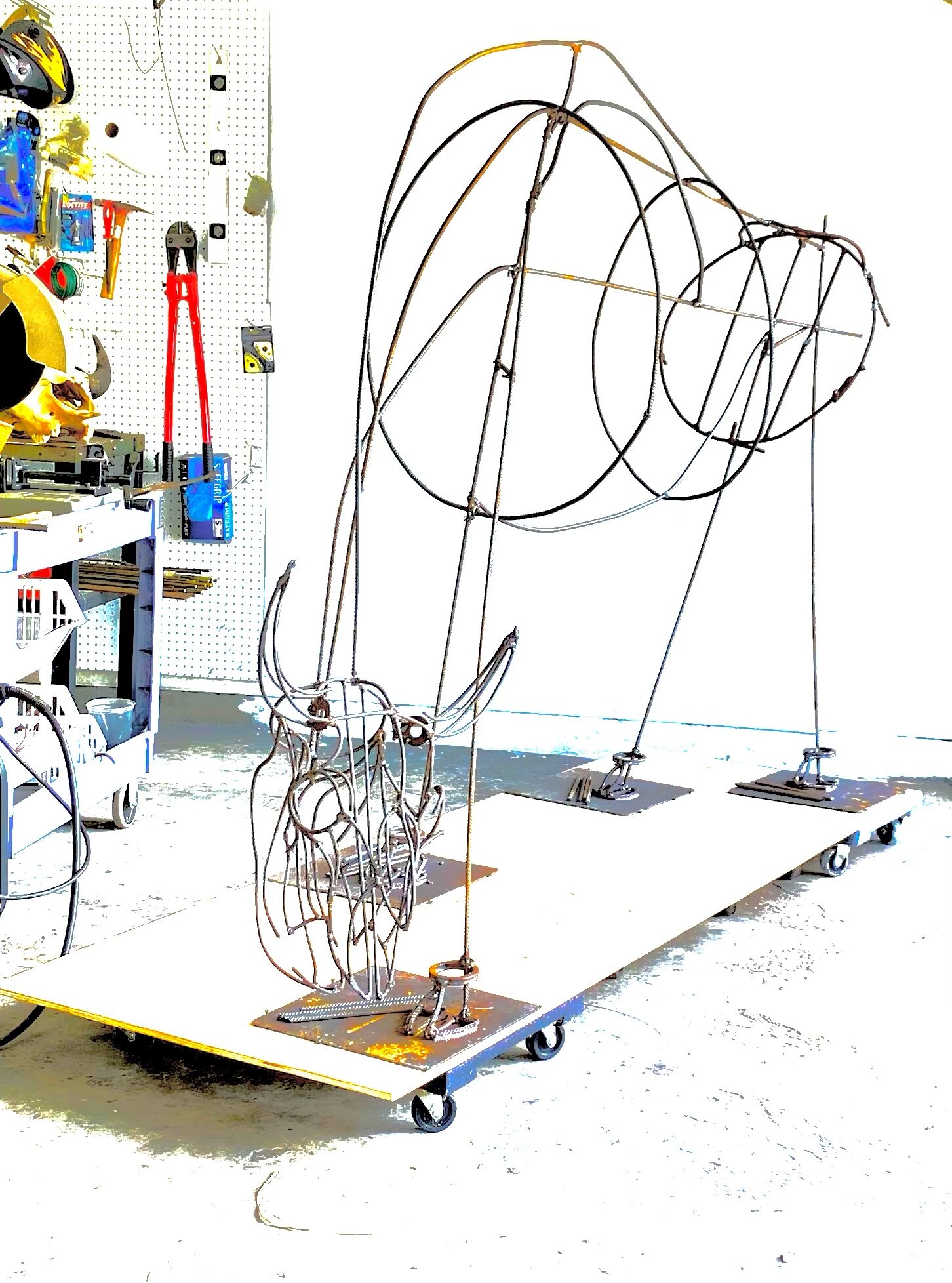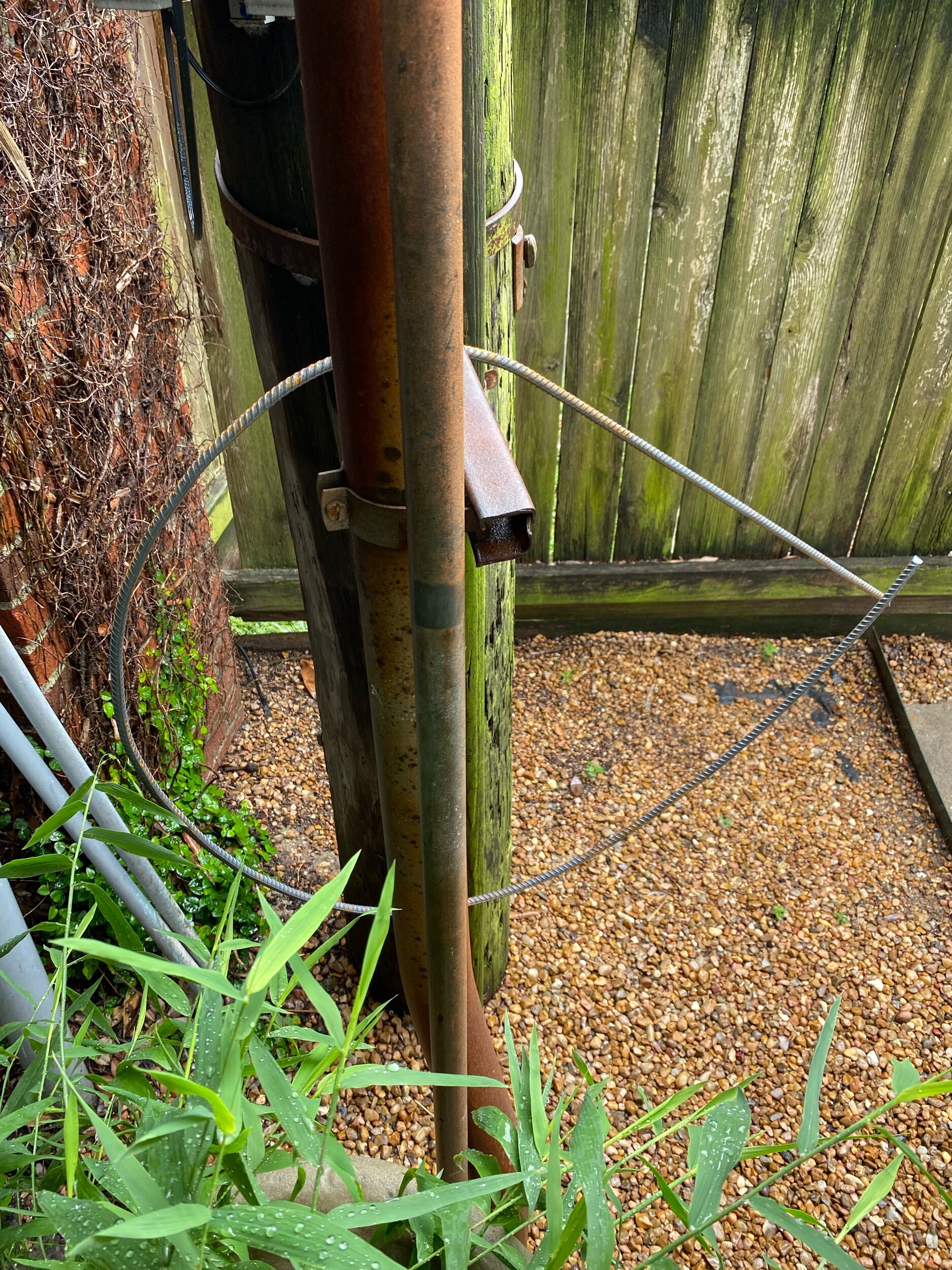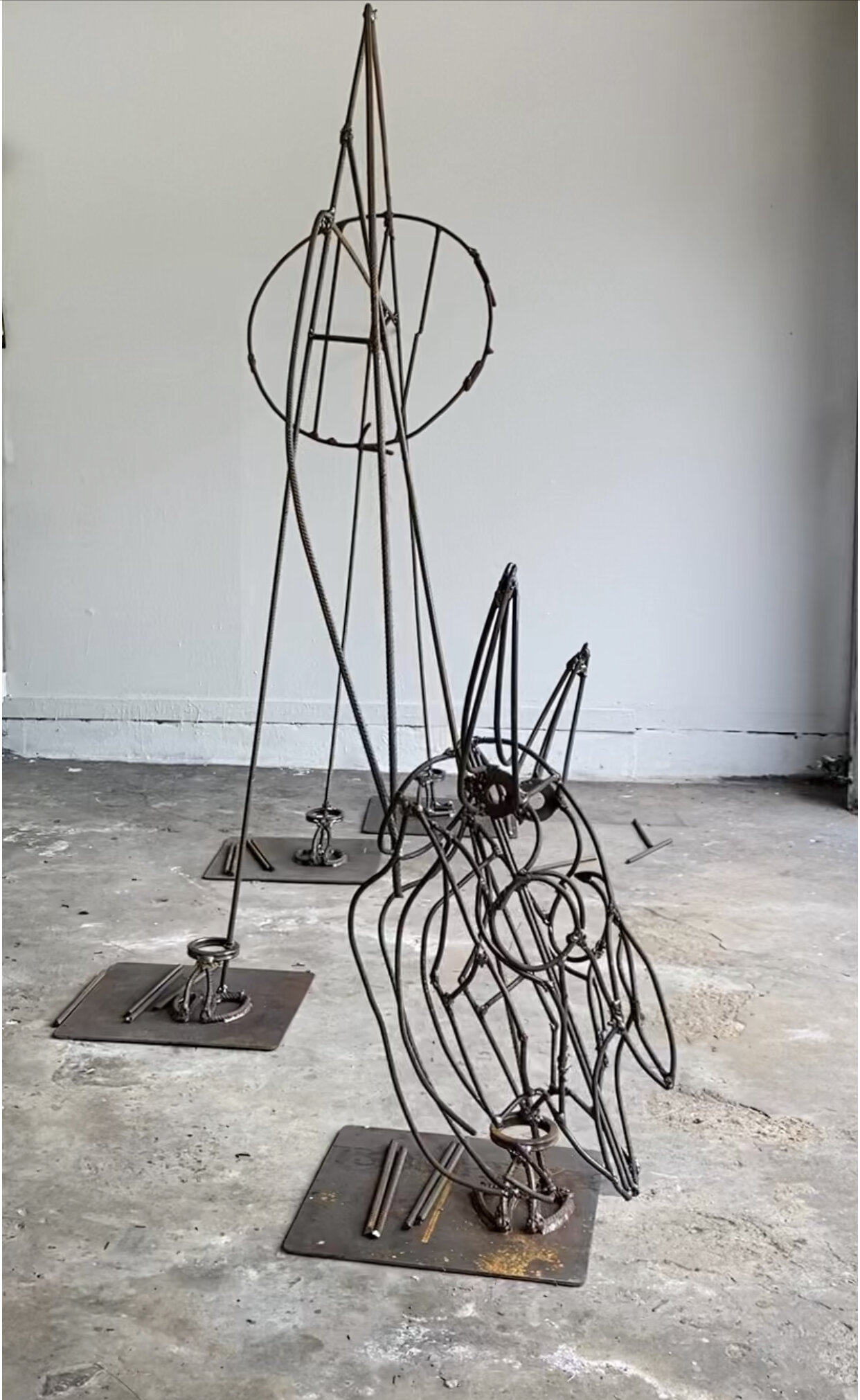20’ more of rebar.
I used 20’ more of rebar today to build the hip bones up on both sides and his right side in the stomach area of his side. I worked from the hip to his shoulder.
My work space is not large enough to get a good side photo.
Your Custom Text Here
20’ more of rebar.

I used 20’ more of rebar today to build the hip bones up on both sides and his right side in the stomach area of his side. I worked from the hip to his shoulder.

My work space is not large enough to get a good side photo.
Stomach, upper hip bones, and more hump.
He still looks like a hybrid giraffe bison, that is only because his muscles and fur come later.

Another big day of welding..I added a big 96” circumference chest. Put the entire piece on four dollies and started his hump. Below are a few pics from todays work.

Behind my garage is a telephone pole. I use it to bend my rebar. This is a side view where I am going to bend the piece for the chest.

Halfway to becoming a bison chest.

Then I use my weight to even out the shape.

I hang the chest over the back and decide if it is big enough.

Next I weld the ends together .

Recycling some old dollies from past work and deciding on the best plan. Balance and portability is the goal. The brown paper is the footprint of my bisons. Each leg is supported by a dollie.

Thanks to Curtis for getting me the plywood and helping me mount the beast. This is just for while I work on the sculpture and for transportation. It is not part of the work.

Just goofing around

My garage studio assistant is taking a sun break.

Starting to assemble the hump.

And that's a wrap.
July 5th.
Attaching the head—
I welded just one connection from the neck to the head. As I assemble other parts of his body I will continue to evaluate the position of the head. I want him to be his reaching to the side searching for the next blades of grass within the reach of his massive head and tongue. With only one weld I can easily cut it off if I decide it is not in the right place or at the right angle. I do enjoy having a bobblehead bison in my garage for a while.
Building the girt—
I happened to have a circular scrap piece of rebar almost the right size. I created it years ago to be a round seat for a faux bois chair that was started and not finished. I turned it into the basis for the bison’s rear hip girth/stomach.
It is a little small, the small size gives me the flexibility to add to it exactly where I want it to protrude. As I get more elements worked out I will make it larger by adding the back hip bones that protrude. t is a lot easier to add pieces as I build him than to cut out pieces.

1 small tack world neck to head. Just to see where I want it.


"If you want to make small changes, change how you do things;
if you want to make big changes, change how you see things."
— In Dirt to Soil, Gabe Brown
How do we restore an ecological balance in Houston? We see Houston in the global ecosystem, see our relationship with wildlife and sea life of the western hemisphere.

Houston
See — Houston can balance humanity and urban wildlife.
Site-Specific installation: Symbiosis is a micro-ecosystem in an important ecological space.
Houston is 600 square miles of mostly privately owned land inhabited by 2.3 million organisms, on the Gulf Coast of South-Eastern North America. Its rainwater runoff feeds the ocean and impacts reefs one hundred miles into the seas. Chemicals from Houston are reported killing reefs 100 miles into the Gulf.

Drain
See — The pesticides, herbicides, and fungicides used to keep Houston’s commercial, residential city and county landscapes manicured are leached by rainwaters that drain into the Gulf of Mexico from our streets.
The plants in Symbiosis do not need chemical inputs to thrive. They have evolved to withstand droughts floods and freezing temperatures.
Located near the lower apex of the triangular-shaped North American continent Houston’s land and water provide nesting, hydration, and nutrition for animals that utilize this critical migratory pathway that funnels migratory life between the northern and southern continents of the western hemisphere. More than one in four birds in the U.S. and Canada has disappeared within my lifetime. Birds play crucial roles in maintaining an ecological balance on the coastal prairie, from eating mosquitos to providing food for scavengers and decomposers.

One In Four Birds In the US Has disappeared In My Lifetime.
See — that birds play crucial roles in maintaining an ecological balance on the coastal prairie, from eating mosquitos to providing food for scavengers and decomposers.
Symbiosis is building living soil that supports bugs, beetles and insects that birds need to feed their young.
A male American Robin sits on the fence at Lawndale at the light of day June 18th, 2021 with Gulf fritillary larvae in his mouth. Until Symbiosis was installed birds flew over Lawndale. The garden was sterile of what modern civilization calls landscape pests/what birds feed their young. The sculpture garden did not offer food or habitat for birds.

Larvae of Gulf Frittilary butterfly – Detail of Symbiosis
See — An important nutrient necessary for birds young to thrive.
With native plants in our urban gardens and commercial outdoor spaces, chemical inputs are not necessary. Chemical-free yards will help bring back the 1107 species once common in the Coastal Prairie.
Houston, the site, has experienced extreme flooding and weather conditions. We are located where once was the Coastal Prairie ecosystem that sequestered Carbon like an upside-down rainforest and absorbed water like a sponge. Of that original landscape, only 1% still exists. And yet, we can see an opportunity to capitalize on Houston’s reputation as the city of energy and cultural diversity. We can mitigate global warming and extreme weather conditions by changing how we see our role in a balanced ecosystem.

Lawndale Symbiosis
Lawndale’s sculpture garden is a micro-ecosystem within an important macro-ecosystem that casts a wide net.

Symbionts
The Passiflora incarnata provides nectar for pollinators. Native bees are the original regenerative farmers, they take nectar and regenerate the flower pollinating the Passiflora incarnata.
This is one species of the 4,000 bees native to the US. (Please note this is not a honey bee. Honey bees are not native to the US. They are part of the industrial farming ecological problem.)
I see an opportunity to create the visual for environmental change. I see hope.
“Look closely at nature and you will understand everything better” - Albert Einstein
Look closely at your micro-ecosystem.
To sustain is not enough. Our civilization has depleted the Earth's soil. It is not enough to sustain a depleted planet; we must all do our part and regenerate soil health to sustain life. Regenerating the Earth’s soil is an ongoing DIY project.
ART CAN ONLY ACTIVATE CHANGE WITH YOUR ADDED PERFORMANCE
—If you care about the environment, help get the conversation going and restore an ecological balance in Houston. Post one image of Houston native plants and or wildlife on Instagram #lawndalesymbiosis and tag two friends.
In addition, forward this to two friends.
Ask two friends to do the same, and ask them to ask two more friends, building a pyramid of activism.
For an enhanced experience viewing Houston’s wildlife and landscape I recommend the citizen science apps
“iNaturalist” and “Seek”.

—The last thing you see when you leave the Museum. It is worthy of bookend status to a visit to the Museum; a water feature is a holistic system study. Without a water feature, an urban garden can not be chemical-free. It is a critical component for all walks or flights of urban life. The trailer a hole, whole, and holistic is immersion art.
Read moreLagerstromia indica —The ways of sculpting symbiotic relationships.
In January of 2021, I shaped the Crepe Myrtles. The living organisms impacted by this creative work are an assemblage of considerations. In holistically sculpting a regenerative site-specific sculpture of living organisms, I have to balance the hierarchy of the living creatures; with every cut, I ask how it will impact the whole?

Golden-eye Lichens - Teloschistes chrysophthalmus- Native to the United Kingdom these lichens survive in harsh environments where algae cannot normally survive. Lichens enable algae to live all over the world. They also provide a means to convert carbon dioxide in the atmosphere into oxygen. I found two small patches on one of the Lawndale Crepe Myrtle’s. I took this before the Texas freeze. It survived but is now struggling. Lichens only grow on Crepe Myrtle’s that are struggling, but they do not harm the Crepe Myrtle’s. I am hunting for more information about the relationship between the lichens and the Crepe Myrtle’s.
Cutting-clipping-chopping, I work to balance and enhance four features; make them aesthetically attractive, shape the Crepe Myrtle branches to benefit the birds, the neighboring community, pollinators and other metropolitan creatures underserved an unknown. I researched how landscapers recommend you prune Crepe Myrtles. I did not want to Crepe Murder them.

Extraction
LOCAL CRIME SCENES
EVIDENCE OF THE COPYCAT MURDERS PLAGUING HOUSTON’S WILDLIFE HABITATS.
I also questioned past practices developed without considering the impact on nature. Landscapers recommend cutting away all horizontal branches for human visual pleasure. That gave me pause—without any horizontal elements, how do birds and squirrels support their nests? I started looking around at birds' nests, something I do all of the time anyway. I observe birds building their nest in protected areas of trees where many cross branches stabilize their nests and protect from wind, sun, and predators.
BIRDS NESTS, PROTECTED FROM WIND, AND SUN BY A WEB OF TREE BRANCHES, AND
HIGH IN THE TREES, SAFE FROM PREDATORS ATTACKING FROM ABOVE.
BIRDS NESTS, PROTECTED FROM WIND, AND SUN BY A WEB OF TREE BRANCHES, AND
HIGH IN THE TREES, SAFE FROM PREDATORS ATTACKING FROM ABOVE.
Left- high in the neighboring Crepe Myrtle is a nest.. RIGHT- A close-up showing how much protection the web of limbs provides for the nest.
If I were only shaping the trees for the birds, I would not cut a twig. For the neighbors walking on the sidewalk, I used the sculpting method of extraction to remove all branches poking out of the fence under 6 feet.

A Neighbor walking along Travis Street. In the future, the white Crepe Myrtles will canopy the sidewalk and provide a shaded path.
On the fence's museum side, I pruned the trees high off the ground as the flowering natives we plant beneath them will need lots of sunshine to support various pollinators. I managed to create a few nooks and Ys where limbs came together. Next year, the trees should be tall enough to provide lots of safe branches for birds to perch on that will stretch high over the sidewalk and shade the neighbors.

I picture a row of clouds spun like cotton candy out of white Crepe Myrtles blooms arching over the fence protecting those strolling from their townhouses to the museums, hiding powerlines from view. — time will twll.
The trees limbs are the armature for several components of the assemblage.